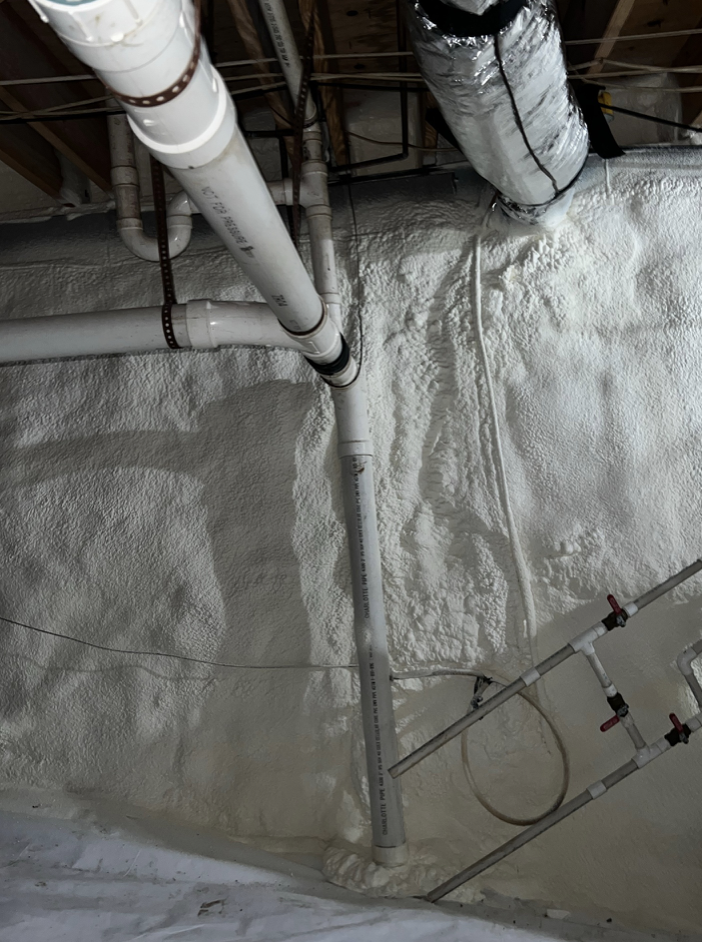Crawl Space Encapsulation in Middle Tennessee

Your crawl space might be out of sight, but it should never be out of mind. In Middle Tennessee, where humidity is high, rainfall is frequent, and clay soils hold moisture, crawl spaces are one of the most vulnerable parts of the home. Left unmanaged, they become a breeding ground for mold, pests, and even structural damage.
At Koala Insulation of Nashville, we’ve helped hundreds of homeowners across Nashville, Franklin, Brentwood, Murfreesboro, Mt. Juliet, Nolensville, Smyrna, Thompson’s Station, and Hendersonville reclaim their crawl spaces and protect their biggest investment. Let’s break down the science, the code, and the smartest solutions for long-term efficiency and peace of mind.
The Science of Crawl Spaces & Efficiency
A healthy crawl space comes down to three essentials: keeping water out, controlling the air inside, and managing humidity.
- Stack Effect – this principle explains why air and water vapor rise. This means whatever is in the crawl space is going to rise through your home making it extremely important for home health to manage what’s going on below your feet.
- Manage entry points – Sealing vents, doors, and cracks prevents humid outside air, pests, and pollutants from entering.
- Manage groundwater – If drainage isn’t handled first, everything else fails. French drains, sump pumps, or other solutions are often needed to eliminate standing water before insulation and encapsulation can be effective.
- Control humidity – The ideal relative humidity is 45–55%, aiming for the middle. Once humidity climbs above 60% for 48 consecutive hours, conditions are right for mold growth to begin.
When these basics are ignored, Tennessee’s climate takes over—leading to mold, musty odors, and rising utility bills in homes from Spring Hill to Mt. Juliet.
Crawl Space Codes in Tennessee: Vented vs. Encapsulated
Building codes in Tennessee allow for two crawl space pathways: vented or unvented (encapsulated).
Option 1: Vented Crawl Space
The traditional method uses foundation vents to promote air circulation. This approach may work in dry climates, but in humid areas like Tennessee, it often makes moisture problems worse.
- Vapor barrier: A Class 1 vapor retarder (such as 6-mil polyethylene sheeting) must cover the exposed earth floor and extend up the foundation walls.
- Ventilation openings: Net area of vent openings must be at least 1 square foot for every 1,500 square feet of crawl space when a vapor retarder is installed.
- Insulation: Installed in the ceiling of the crawl space (between the floor joists). In Middle Tennessee, code requires R-19 floor insulation, which must remain in permanent contact with the subfloor.
Option 2: Unvented (Encapsulated) Crawl Space
This modern approach seals and conditions the crawl space to control moisture and improve efficiency. For humid climates like Tennessee, encapsulation is often the more effective option for long-term health and energy savings.
- Vapor barrier: A continuous Class 1 vapor retarder (minimum 6-mil polyethylene) is required to cover the ground. All seams, overlaps (minimum 6 inches), and edges must be taped and sealed. The barrier must extend at least 6 inches up the foundation wall and be attached and sealed to it.
- Insulation: Installed on the crawl space walls instead of the floor. In Middle Tennessee, code requires R-10 continuous insulation on foundation walls.
- Conditioning: The space must be mechanically conditioned using one of the following:
- Mechanical exhaust – A fan that continuously exhausts air at a rate of 1 CFM for every 50 square feet of crawl space.
- Conditioned air supply – HVAC supply air at a rate of 1 CFM per 50 square feet of floor area.
- Dehumidification – A permanently installed, properly sized dehumidifier.
Why Vented Crawl Spaces Struggle in Middle Tennessee
Here’s the challenge we see repeatedly in our market: the air doesn’t actually move enough in vented crawl spaces, even when the code requirements for vent openings are technically met. Instead, hot, humid Tennessee air sits stagnant. With no humidity control in place, the crawl space becomes damp and unhealthy.
Fiberglass insulation, required at R-19 in vented crawl spaces, often gets a bad rap. Mold inspectors and remediators sometimes point to the insulation itself as the cause of mold growth. That’s not true. The problem is excessive humidity. Fiberglass acts like a sponge, soaking up the moisture and holding it against the wood floor joists. This keeps the wood wet long enough for mold to start growing.
Unfortunately, some remediation companies in areas like Madison, Old Hickory, and Antioch will simply pull out the insulation, spray something on the wood, and call the job done. But the humidity issue remains untouched. Without addressing the true root cause, homeowners are left hoping the problem is solved, when it’s only a matter of time before the moisture returns.
Two Pathways For Encapsulation
In the field, we come across two main crawl space strategies:
- Full-Focused Approach
- Moisture control + wall and rim joist insulation + air sealing.
- This system reduces drafts, lowers utility bills, improves indoor air quality, and keeps your crawl space dry.
This is our recommendation. Control moisture and improve the home’s comfort and efficiency.
- Moisture-Control-Only Approach
- Often performed by remediation or mold companies.
- They focus on stopping mold or water but rarely insulate the walls or air seal. The will take plastic all the way up the walls but not insulate them or the rim joists.
- Efficiency and comfort are sacrificed, and the crawl space may still waste energy even though moisture is reduced.
If you want both health and savings, efficiency + moisture control together is the winning formula. Homeowners from Murfreesboro to Dickson see the difference when all three pieces come together.
Why Dehumidification Is Non-Negotiable
No matter how well a crawl space is sealed, Tennessee humidity requires an active solution.
- Supply air only method: Some new construction homes pump small amounts of HVAC air into crawl spaces as a shortcut. The theory is that cold, dry air will lower humidity as it warms. In reality, we’re seeing this fail across Middle Tennessee. Mold is still growing, and humidity remains unchecked.
- Dedicated dehumidifier: A must-have for long-term success. The best units today are Wi-Fi enabled, allowing homeowners to monitor crawl space humidity from their phone and get peace of mind year-round.
The Best System for Protecting Your Home
In our experience, the most reliable system for Middle Tennessee crawl spaces includes all three elements working together:
- Insulate walls and rim joists for maximum efficiency.
- Manage moisture with drainage, vapor barriers, and proper sealing.
- Install a dedicated dehumidifier to maintain healthy humidity levels.
This combination not only protects your crawl space but also your indoor air quality, your utility bills, and your home’s long-term value. Whether you live in Franklin, Nolensville, Murfreesboro, Brentwood, Mt. Juliet, Smyrna, or Hendersonville, this system is proven to work.
Protect Your Crawl Space Today
Your home is your largest investment. Don’t let what’s happening below the floor compromise your comfort, health, or efficiency. At Koala Insulation of Nashville, we specialize in crawl space encapsulation, insulation, and dehumidification designed for Middle Tennessee’s climate.
👉 Schedule your free evaluation today at KoalaInsulation.com/Nashville.
Find Your Location


Get a quote



